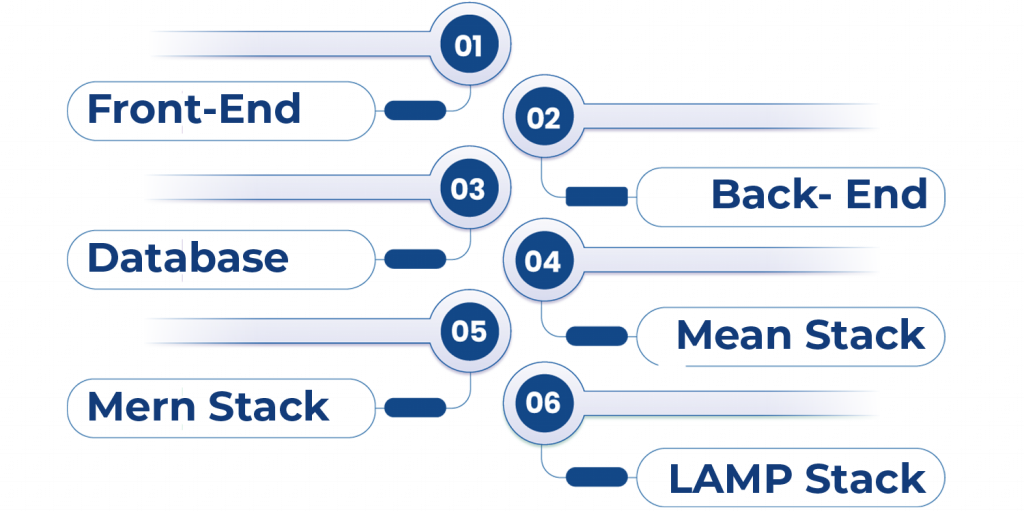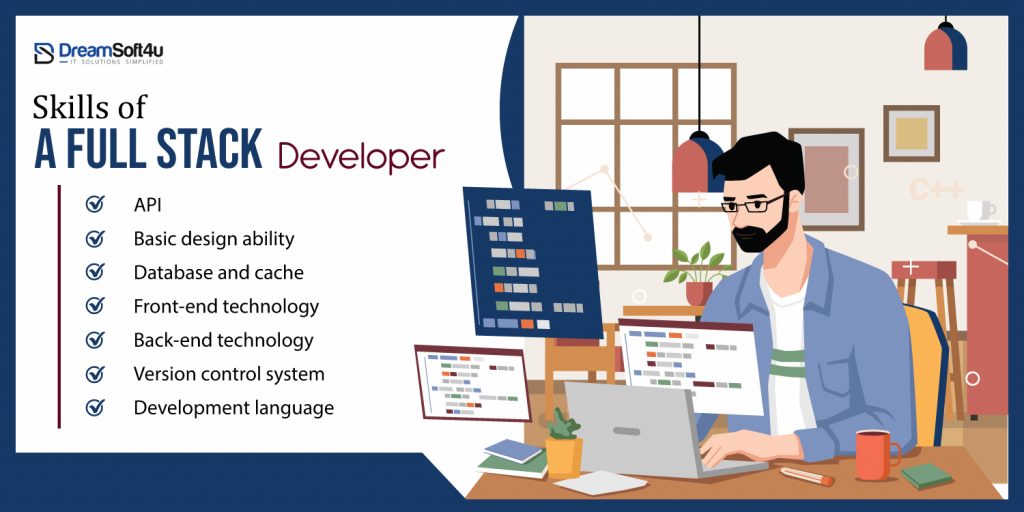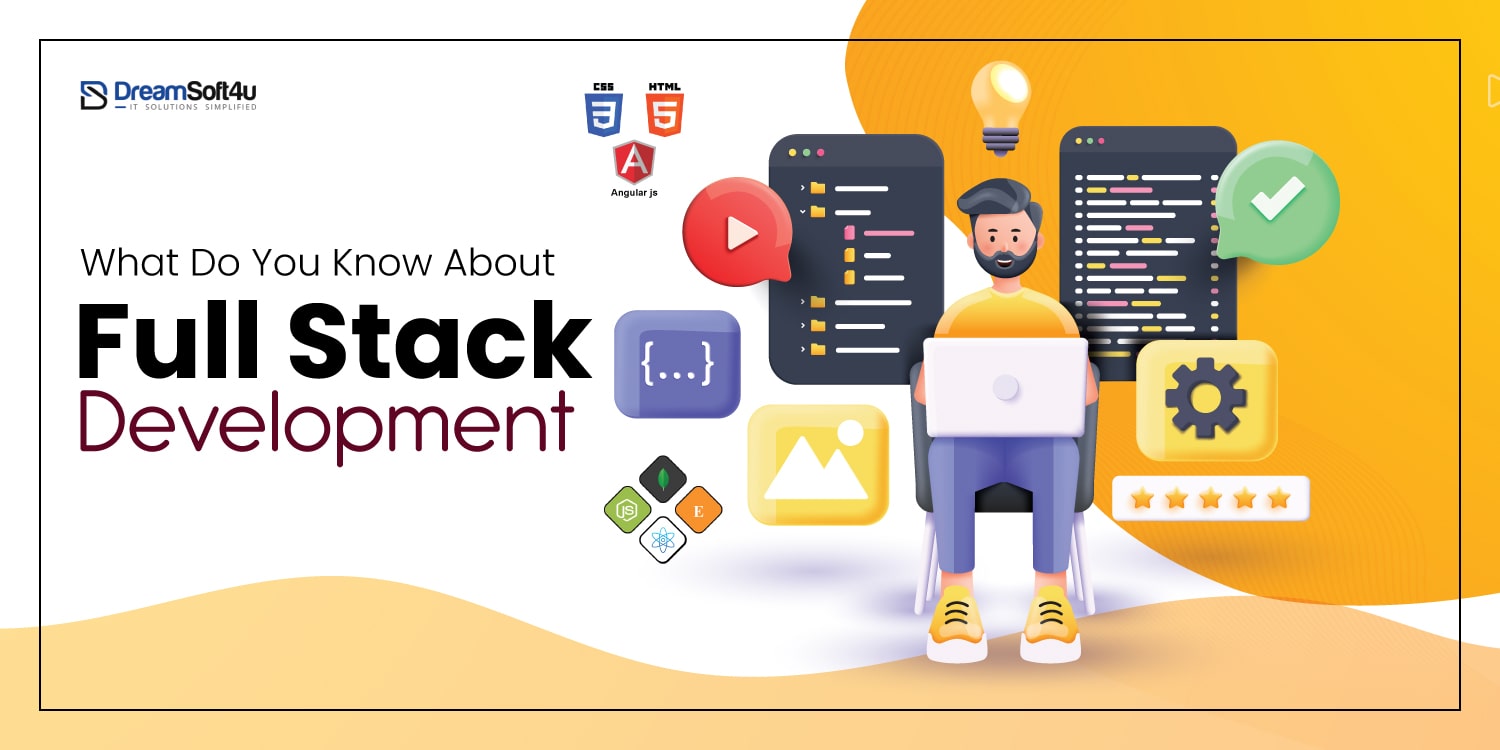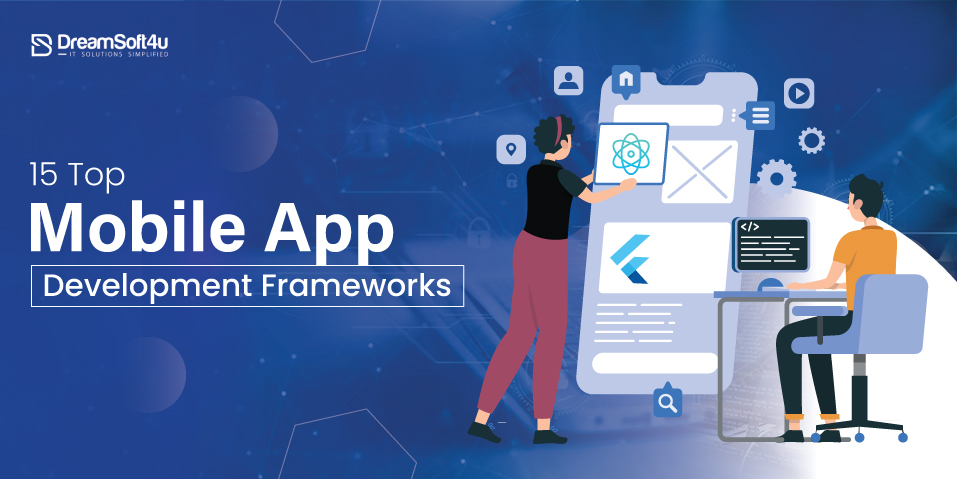Have you ever wondered how programs and websites work from beginning to end? That is how full-stack development works its magic! The skill of creating both the strong internal logic and the user-friendly interfaces we deal with is what keeps everything running smoothly. Consider a full-stack developer as a digital architect who creates the building’s facade, establishes the framework, and makes sure everything works properly. A broad skill set is necessary for this in-demand area, which enables developers to realize concepts from inception to completion. Get a detailed breakdown of the full-stack development process and who is involved in the complex process of app development.
You May Also Like:
Table of Contents
ToggleWhat is Full Stack Web Development?
It refers to the development of both portions of the web application- the front end (known as the client-side) and the back end (known as the server-side).
To be a full-stack web developer, the developer should have the knowledge and ability to design complete web applications and websites. They know front-end, backend, database, and debugging of applications or websites to develop.
Pros and Cons of Full Stack Development
| Pros | Cons |
| Full control over the entire development process | Requires a broader skillset, potentially leading to shallower expertise in each area |
| Improved communication and collaboration within a single team | Can be overwhelming for smaller teams or individual developers |
| Faster development cycles due to streamlined communication | Debugging issues can be more complex due to the interconnected nature of the stack |
| Increased flexibility in choosing technologies | May require additional time and resources to stay up-to-date with all the technologies involved |
Full Stack Development Technologies
Let’s discuss the technologies related to Full Stack development.

1. Front-End
It is known as the client-side. It is responsible for user experience. It is managing what users interact with and see in the software. It is the visible part of the application or website. It helps the users to interact with the front-end portion of the application or website. It is the user interface of the application.
The one who works on the front-end knows client software like CSS, JavaScript, and HTML.
The two core technologies of web pages are HTML (Hypertext Markup Language) and CSS ( Cascading Style Sheets). HTML is responsible for the structure of a page, and CSS is responsible for the visual layout. For making dynamic pages, JavaScript is responsible. It is a programming language. The trademarks of JavaScript are scrolling or dropping, and dragging. It is also used to simplify and speed up the development process.
Front-End Languages
Let’s discuss these front-end languages. These languages are used to build the front-end portion.
HTML- HTML refers to Hyper Text Markup Language. Markup language helps in designing the front end of web pages. Hypertext describes the link between the web pages. The markup language is responsible for explaining the text documentation within the tag. HTML is the combination of Hypertext Markup Language
CSS- CSS refers to Cascading Style Sheets. CSS simplifies the process of making the web presentable through its designed language. Due to CSS, you are allowed to style your web pages.
JavaScript- JavaScript is a famous Scripting language. It is responsible for making the site interactive for the user. It enhances the utility of a website that helps to run cool games and web-based software.
Front-End Frameworks
Let’s talk about some front-end frameworks and libraries:
Angular.Js- Angular.Js is a free and open-source front-end framework. It is based on JavaScript. It is responsible for developing single-page web applications (SPAs). It is an open-source framework. So, you can use it for free and change it in your way. It is a continuously expanding and growing framework that changes static HTML to dynamic HTML.
React.Js- React.Js is a flexible, declarative, and efficient JavaScript library. It is responsible for building user interfaces. It helps in making the view layer of the application. Facebook maintains it.
Bootstrap- Bootstrap is a collection of free and open-source tools that creates responsive websites and web applications. It is the most popular HTML, CSS, and JavaScript framework for developing a responsive mobile-first website.
jQuery- It simplifies the interaction between JavaScript, the Document object model (DOM), and HTML/CSS documents.
SASS is the most mature, robust, and reliable CSS extension language. It helps in extending the utility of an existing CSS of a site.
Some other libraries and frameworks are- Express.js, Backbone.Js, UI, Foundation, Ember.Js, Materialize, etc.
2. Back-End
Back-end is the server-side development of the web application or website. Its primary focus is on how the website works. It receives and processes the request of users and the database used to store data. It is not a visual process. It is happening all behind the web applications. Through queries and APIs by client-side commands, it manages the database. It is the brain of a web application and is considered the logical side.
Some languages, frameworks, and libraries are used to build front-end portions. These languages, frameworks, and libraries are discussed below:-
PHP- It is a server-side scripting language. It is specifically designed for web development. It is known as the server-side scripting language because its code is executed on the server-side.
C++- It is a powerful general-purpose programming language. The developers use this programming language in competitive programming. The back-end portions of the web applications also use this language.
Java- It is the most popular programming language and development program. The programmers use this language to develop mobile apps, websites, desktop apps, web apps, etc. All the components of Java are readily available.
Python- Python is a general-purpose, high-level, interpreted computer programming language. It is not specialized for specific problems; it is used to create various programs. It helps you integrate systems more efficiently and work quickly.
JavaScript is used on both sides ( front-end and back-end) as a programming language.
Node.Js- Node.js is an open-source server environment that supports various OS Platforms including Windows, Linux, Unix and MacOS. It can run javascript code outside of the web browsers to create scalable applications. It is based on the V8 javascript engine. Most developers use Node.js to build web based applications and for back-end APIs services and traditional web apps.
Back-End Program Languages
Some of the back-end program languages are given below-
C#– It is one of the general-purpose programming languages. It is used in programs and applications like cloud-based services, desktop apps, mobile applications, games, websites, and enterprise software.
Ruby– It is one of the most popular programming languages. It is similar to Python. It is used on websites like Kickstarter, GitHub, Hulu, and Airbnb.
Go- It is a general-purpose, open-source programming language. You can create reliable, simple, and efficient software with the help of this programming language.
Full-stack web development has three parts- front-end, back-end, and database. We have discussed the two parts above. Now it’s time to discuss the database’s third and last part of Full-stack development.
Back-End Frameworks
Some of the frameworks of the Back-end side are discussed below:
Express.Js- It is a Node.js web application framework. It offers features for creating mobile applications and websites. It is generally used in developing multiple-page, single-page, and hybrid web applications.
Django- It is a high-level Python framework. It is responsible for enabling the rapid development of secure and maintainable websites.
Laravel- It is an open-source PHP Web framework developed by Taylor Orwell. It helps in authentication, caching, sessions, and routing of web projects.
Spring- It is an open-source application framework. It helps in developing Java applications by offering infrastructure support. It is a lightweight framework.
You May Also Like:
3. Database
It is a systematic collection of interrelated data. It helps with in-store modification, retrieval, and deletion of data in data processing operations. It electronically organizes and manages the data in views, schemas, tables, and reports. Due to this, it is easily accessible and manageable.
Oracle- It is a collection of data treated as a unit. It is responsible for storing and retrieving related information related to the query. It helps in solving the problems of information management.
MongoDB- It is an open-source NoSQL database management program and is used as an alternative to traditional relational databases. It is written in C++ language. It helps work with large sets of distributed data.
SQL- It refers to Structured Query language. It is a standard database language that allows you to access and manipulate databases.
We have seen all three parts of Full-stack web development. Now let’s see some popular technology stacks.
DreamSoft4u Since 2003
Get your free quote by the top professionals.
4. Mean Stack
Mean Stack Developers focuses on four top technologies- MongoDB, Express.Js, Angul.Js, and Node.js. It is a free and open-source JavaScript-based software stack. It is used in developing dynamic web applications and websites. It can be written in one language for both client-side and server-side.
M for MongoDB– It is a database.
E for Express.Js– It is a web framework.
A for Angular.Js– It is an open-source front-end JavaScript-based web framework. It develops single-page applications. Google maintains it.
N for Node.Js– Due to its single-threaded nature, it is used for non-blocking, event-driven servers.
You May Also Like:
5. Mern Stack
Even though full-stack developers frequently choose the Mern stack, it’s crucial to realize that these languages usually don’t use pointers for memory management. The Mern stack framework prioritizes high-level development and includes built-in memory allocation and deallocation functions. It simplifies development and reduces the risk of memory-related errors. Here’s a breakdown:
- MongoDB- This document-oriented database doesn’t utilize pointers itself.
- Express.js- Built on JavaScript, Express avoids manual memory management through automatic garbage collection.
- Angular/React/Vue.js (choose one)- These JavaScript frameworks also benefit from garbage collection, so pointers aren’t a core concept for development.
- Node.js- JavaScript on the server side with Node.js also leverages garbage collection, freeing developers from memory management concerns.
6. LAMP Stack
It is an open-source solution stack used primarily in Web development. It is a combination of Linux, Apache, MySQL, and PHP.
Linux- It is responsible for an operating system.
Apache- It is a web server.
MySQL- It is a database management system.
PHP- It is a programming language for web applications.
We have discussed all the technologies, frameworks, languages, and popular stacks of Full Stack development. Now it’s time to see what skills are required to be a Full Stack developer. Before that, we have to discuss the difference between a Full Stack Developer and a Software Engineer.
Who is Full-Stack Developer?
Full Stack developer has expertise in developing both client-side and client-side. They have also mastered HTML/CSS and know how to program a server, program a database, and program a browser. They are not only responsible for handling back-end operations, design, and maintaining the databases of the application but also help in testing and deploying the application as well.
You May Also Like:
Skills of A Full Stack Developer

We have divided the skills of a full-stack developer into two parts. One is technical skills, and the other is soft skills.
Technical Skills
1. Front-End Technology
A full-stack developer must have knowledge and expertise in front-end technologies like HTML, CSS, and JavaScript. He /she can work under frameworks and libraries like React.Js, Angular.Js, SASS, Bootstrap, etc.
2. Back-End Technology
A Full-Stack developer should have knowledge and expertise in back-end technologies like PHP, C++, Java, Python, and frameworks like Express.Js, Laravel, Spring, etc.
3. Development Language
A full-stack developer must know at least back-end programming languages like Java, Python, Ruby, Go, C#, etc.
4. Database and Cache
Knowledge of DBMS is also required to be a full-stack developer. Database software like Oracle, MongoDB, SQL, etc. Caching mechanisms like Memcached, Varnish, Redis, etc.
5. Basic Design Ability
To be a successful developer, a developer should know about designing also. The developer should know the basic prototype design and UI/UX design.
6. Version Control System
A developer can keep track of all the changes made in the codebase with the help of a version control system. Git can help the developer to understand the problems related to code. The developer must know Git to understand how to get the latest code, update parts, and change the other’s code without breaking them.
7. API
It is necessary to know the APIs and web services for a full-stack developer.
Soft Skills
A developer should have technical skills with soft skills. To be a full-stack developer in a firm or corporation, you should have both skills. Some soft skills of a full stack developer are-
- Developers must have time management skills.
- They must be curious to learn new technologies and skills.
- He must be a team player.
- Must know how to lead a team.
- Developers must coordinate with other teammates to achieve common goals.
- He must be an analytical thinker.
Are you looking for a full-stack project managing company?
Reach out to the top Professional to shape your Dreams.
Conclusion
Full-stack development provides a dynamic and fulfilling career path for individuals that have a strong desire to fully comprehend how apps are developed. Although they require a wide range of talents, full-stack developers have the special capacity to connect server-side functionality with user experience. Its broad approach promotes improved collaboration, quicker development cycles, and the potential to realize innovative ideas. Full-stack developers will continue to be at the forefront of technological advancement, influencing the digital experiences of the future.
FAQs
Q1. Hiring Full Stack Developer in India Vs USA: Which is better?
Hiring full-stack developers from India is always more cost-effective and efficient. In fact, Indian full-stack developers are among the highest-rated across platforms like Upwork and Freelancers.
Q2. Are you comfortable integrating with third-party APIs?
Yes, we can seamlessly integrate third-party APIs into your projects. We would still want to learn more about the specific APIs you want and test their compatibility.
Q3. Do you have experience using version control systems like Git?
Yes, we utilize GIT version control for efficient code management. This ensures smooth collaboration within our team.
Q4. Can you provide an estimated timeline and cost for completing the project?
We can share a detailed cost estimate and project timeline. But before that, we need to first understand your full-stack project needs and goals. Feel free to book a free consultation with one of our experts.
We generally sign an NDA with our clients. But we are always happy to answer any specific questions and queries that you may have. Plus, you can visit our case study section where we have shared some of the project case studies (with permission from the client).






















